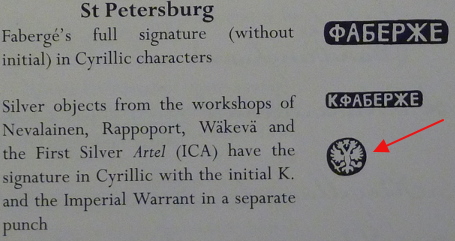Fabergé's marks in St. Petersburg and Moscow?
Posted: Mon Feb 19, 2018 9:20 am
A question is bothering me.
Carl Peter Fabergé was appointed the court supplier title in 1885. My impression is that the mentioned year Fabergé started to punch the double headed eagle on objects produced in Moscow only and marked with the “trade mark” К. ФАБЕРЖЕ but no maker’s mark but of course with the assaying mark of Moscow.
In St. Petersburg the company used the mark ФАБЕРЖЕ with no K. in front. Nonetheless, there were some exceptions. The masters Stefan Wäkevä (SW), Julius Rappoport (IP), Antti Nevalainen (AN) and the 1st silver artel (1CA/ICA) were allowed to punch their mark alongside with Fabergé’s mark in St. Petersburg. As mentioned above the court supplier mark was not punched with the ФАБЕРЖЕ -mark. (...or was it?)
There were, however, some special arrangements for the Moscow market. The mentioned masters punched their mark with the К. ФАБЕРЖЕ mark and the double headed eagle mark and with the assaying mark for St. Petersburg. Those objects were sold in Faberge’s salesroom in Moscow. This was on demand of the Faberge’s Moscow customers (?)
There were some other exceptions too, like Varvara Baladanova, Friedrich Rückert, Ivan Saltykov and Maria Semenova. Some of their production was sold by Fabergé in Moscow. This is, anyway, another case and let us not mix it with my assumption above. It could be discussed in another topic.
Summa summarum, is my assumption correct and if not, what should be corrected?
A puzzled Qrt.S
Carl Peter Fabergé was appointed the court supplier title in 1885. My impression is that the mentioned year Fabergé started to punch the double headed eagle on objects produced in Moscow only and marked with the “trade mark” К. ФАБЕРЖЕ but no maker’s mark but of course with the assaying mark of Moscow.
In St. Petersburg the company used the mark ФАБЕРЖЕ with no K. in front. Nonetheless, there were some exceptions. The masters Stefan Wäkevä (SW), Julius Rappoport (IP), Antti Nevalainen (AN) and the 1st silver artel (1CA/ICA) were allowed to punch their mark alongside with Fabergé’s mark in St. Petersburg. As mentioned above the court supplier mark was not punched with the ФАБЕРЖЕ -mark. (...or was it?)
There were, however, some special arrangements for the Moscow market. The mentioned masters punched their mark with the К. ФАБЕРЖЕ mark and the double headed eagle mark and with the assaying mark for St. Petersburg. Those objects were sold in Faberge’s salesroom in Moscow. This was on demand of the Faberge’s Moscow customers (?)
There were some other exceptions too, like Varvara Baladanova, Friedrich Rückert, Ivan Saltykov and Maria Semenova. Some of their production was sold by Fabergé in Moscow. This is, anyway, another case and let us not mix it with my assumption above. It could be discussed in another topic.
Summa summarum, is my assumption correct and if not, what should be corrected?
A puzzled Qrt.S

